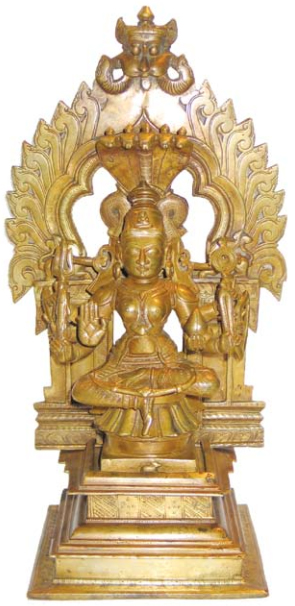
Centre of Jaina Studies Newsletter: SOAS - University of London
In November 2011, the Ackland Art Museum at the University of North Carolina at Chapel Hill received a donation of a copper-alloy icon of a Jain goddess, probably Jvālāmālinī (Figure 1). The icon has no inscription, but its date has been estimated at the seventeenth or eighteenth century, although it might be from the nineteenth century. It comes from south India, from the region of northern Karnataka and southern Maharashtra that is home to many Digambar Jains.
While we are used to seeing examples of excellent copper-alloy Jain icons on display in museums, this one reminds us that a majority of Jain temple icons are of a more middling artistic quality. The workmanship is such that details of the objects she carries in her hands are difficult to discern. In the eight arms, the icon has the following attributes:
Right, upper to lower[1]: trident; an oblong object, possibly a goad; another oblong object, possibly a plant or closed flower; and the abhaya mūdra ("fear not" gesture). Left upper to lower: discus; bow; noose; citron.
The yakṣīs are conceived within Jain cosmology as the śāsana-devīs, twenty-four goddesses each of whom presides over the teachings and community of a particular Jina. Many icons of yakṣīs, especially in the Digambar tradition, include a seated Jina in her crown, as we see in this icon. Above her is a five-headed serpent deity. The goddess is seated in a regal posture upon a lotus. At the base of the icon is a small figure of a bull. The icon is backed by a flaming aureole, which is topped by an auspicious kīrti-mukha ("glory face").

Figure 1. Icon of Jain goddess, probably Jvālāmālinī
South India, southern Maharashtra or northern Karnataka, ca.
17-19th c Copper-alloy, 33.6 x 13.2 x 17.5 cm Ackland
Art Museum, The University of North Carolina at
Chapel Hill. Gift of the Rubin-Ladd Foundation. 2011.34.2a-c.
Complex metal icons in South Asia are often constructed of multiple pieces, which are cast separately using the lost-wax process, and then either soldered together, or fitted together for worship. This icon represents the latter process, of separate pieces that come apart and are pieced together for worship. The icon comes apart into three pieces: the body of the goddess together with the lotus on which she sits and the topmost part of the square base; the backing surround (parikara); and the bottommost part of the square base. Both the style of the incising and the color of the metal differ between the body of the goddess and the other two pieces. This may indicate that greater attention was devoted to the body of the goddess than to the surrounding structural pieces, or that they were cast at different times and later joined. It is possible that the surround and the lower base were intended for a different deity, not even necessarily a Jain one.
This construction is typical of copper-alloy icons from the region of Maharashtra and Karnataka. Leo S. Figiel has described the process as follows:
With regard to castings from Maharashtra/Karnataka, the following points are to be noted: larger, solid or hollow cast sculptures ranging from approximately 8 to 24 inches (20 to 61 cm.) in height, are usually cast in sections; figures may consist of two, or more frequently three parts: base, figure and back arch.[2]
Another feature of the Ackland icon allows us more firmly to identify it with the regional tradition described by Figiel. The part that includes the body of the goddess is designed to slide into the square base to give it stability. This is precisely a feature described by Figiel:
In those cases when two or three solid parts are cast separately, the base and the figure are made so that the flat, inferior surface of the figure will slide into a slot prepared at the upper surface of the base from back to front. This is also unique to Maharashtra and adjoining regions of Karnataka.[3]
The identification of this goddess as Jvālāmālinī is not definitive. There is sufficient variation among the attributes of icons of Jain goddess that the attributes alone are rarely sufficient to identify a goddess. That this goddess has eight arms, and not two or four, lends support that she is the Tantric goddess Jvālāmālinī, one of the most popular Jain goddesses among Digambar Jains in Karnataka. While the eight attributes do not tally exactly with those of any eight-armed Jvālāmālinī icons as described in a number of classical Digambar textual sources cited by S. Settar,[4] there is sufficient overlap that the identification as Jvālāmālinī is likely. The vehicle for Jvālāmālinī is a bull, which is found at the base of the icon.
There are, however, two factors that might throw doubt on this identification. Icons of Jvālāmālinī usually show flames emitting from the back of her crown. In this case, there are no flames on the sculptural piece that contains the body of the goddess; the flames are found only on the separate surround, which, as indicated, may have been cast for a different icon and even deity. Second, the multi-hooded serpent deity above her crown is usually a feature of the Jain goddess Padmāvatī, not Jvālāmālinī.
The evidence for identifying the icon as Padmāvatī, however, is not strong enough to support a positive identification. If this icon were of the goddess Padmāvatī, one would expect the Jina in her crown also to be shielded by a multi-headed serpent, for Padmāvatī is associated with the Jina Pārśvanātha. The Jina in the crown of this goddess is not shielded by a serpent deity. Second, if the goddess were Padmāvatī, one would expect to find as her vehicle at the base of the icon either a snake or a cock. Third, icons of Padmāvatī in south India are more often of two or four hands, betokening her more exoteric nature. Fourth, while the serpent hood is usually associated with Padmāvatī among Jain goddesses, this is not a sure identifying mark. For example, H. D. Sankalia published an icon of a 16th century north Indian Digambar goddess, in the collection of the Museum of the Indian Historical Research Institute at St. Xavier's College, Mumbai, that combines the serpent-hood iconography of Padmāvatī with the attributes of the Jain goddess Vairoṭī.[5]
Closer in time and place to the Ackland Art Museum's icon, a number of copper-alloy icons of Hindu deities in the Leo S. Figiel Collection (now at the Peabody-Essex Museum in Salem, Massachusetts) are seated in front of separate backing surrounds that include five-headed serpents. These icons date from the 14th through the 19th centuries. Deities whose icons have a covering serpent include Khaṇḍoba, Durgā (in several iconographic forms), Hanumān, Nandī, and Vīrabhadra, as well as a number of liṅgas and mukha-liṅgas.[6] Some of these are icons of deities whom one might expect to be shielded by a serpent deity, but not all of them. We are dealing here with a regional sculptural tradition, in which it was acceptable to depict a five-headed serpent deity shielding a wide array of central deities. This is especially evident in one image in the Figiel collection, of a bronze stand for a deity that includes the five-headed serpent placed to protect the main icon, a flaming aureole, and a kīrtimukha on the top of the image. However, there is no central icon, so this stand was clearly designed with the understanding that the protecting serpent-deity could be cast separately from the body of whatever deity was the focus of the icon. The surrounds on the icons from Maharashtra and Karnataka in the Figiel collection also feature flaming aureoles, makaras, and kīrti-mukhas, similar to the Ackland icon. While the Figiel collection does not include any Jain icons, the Ackland goddess that I have identified as Jvālāmālinī clearly fits into this late pre-modern regional tradition that spread across religious divisions, in ways that Jain sculpture has always interacted with regional artistic traditions. The artistic quality of the Ackland Jvālāmālinī is not as fine as those in the Figiel collection. While some scholars would interpret this to mean that it therefore should be dated to the last phase of this regional tradition, it may instead indicate that throughout the history of this regional style, as with all other artistic styles in South Asia, craftsmen operated with a range of artistic skill.
In sum, this icon can reasonably be identified as the goddess Jvālāmālinī, although this judgment is made with due caution. The iconographic anomalies are not uncommon among Jain goddess icons. Further, we can reasonably locate this icon within the regional copperalloy casting tradition of southern Maharashtra and northern Karnataka.
The author thanks Phyllis Granoff, Hampana Nagarajaiah and Peter Nisbet for their help in preparing this notice.
John E. Cort is Professor of Asian and Comparative Religions at Denison University in Granville, Ohio, USA.
In describing a sacred image, right and left refer to the perspective of the deity, not the viewer. "Right," therefore, refers to the deity's right, not the viewer's.
Leo S. Figiel (with with contributions by Cornelia Mallebrein). Ritual Bronzes of Maharashtra and Karnataka, Including the Bhuta Region. Boynton Beach, FL: Leo S. Figiel, 2007, p. 13
S. Settar, "The Cult of Jvālāmālinī and the Earliest Images of Jvālā and Śyāma." Artibus Asiae 31 (1969), pp. 309-20.
 Prof. Dr. John Cort
Prof. Dr. John Cort